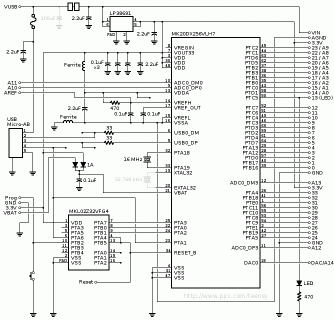Markk
Well-known member
Hi
It's amazing how simple solutions have generally become with DMAChannel. Great work and thank you!
Still I'm stuck here: I tried to find out if a digital pin input (edge) can trigger a DMA transfer (random pulses from outside, not periodic).
NOTE: I know I can trigger DMA from the comparators, but I've already used up those.
I've looked at the DMAChannel source code and examples as well as the K20 datasheet but it still eludes me, how this all works.
The most promising was this: https://github.com/PaulStoffregen/OctoWS2811/blob/master/OctoWS2811.cpp:
But: if I look at the K20 Signal Multiplexing and Pin Assignments "ALT3" mapping (which I assume is enabled by PORT_PCR_MUX(3)) for Pin 16 (which is K20 Pin 35) I see it is mapped to FTM1_CH0, the underlying timer that (I guess) was prepared using the analogWrite/PWM setup. It isn't the pin at all (is it?). Now I'm completely confused... also I don't understand the ports A, B, C...
Is there a way for digital inputs' DMA triggering at all?
Thanks for all help!
-Markk
It's amazing how simple solutions have generally become with DMAChannel. Great work and thank you!
Still I'm stuck here: I tried to find out if a digital pin input (edge) can trigger a DMA transfer (random pulses from outside, not periodic).
NOTE: I know I can trigger DMA from the comparators, but I've already used up those.
I've looked at the DMAChannel source code and examples as well as the K20 datasheet but it still eludes me, how this all works.
The most promising was this: https://github.com/PaulStoffregen/OctoWS2811/blob/master/OctoWS2811.cpp:
Code:
// pin 16 triggers DMA(port B) on rising edge (configure for pin 3's waveform)
CORE_PIN16_CONFIG = PORT_PCR_IRQC(1)|PORT_PCR_MUX(3);Is there a way for digital inputs' DMA triggering at all?
Thanks for all help!
-Markk


